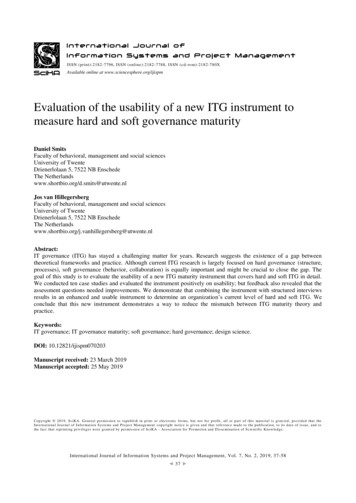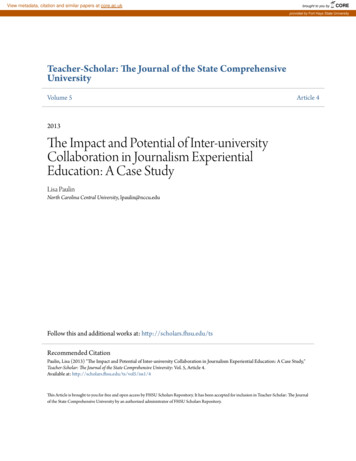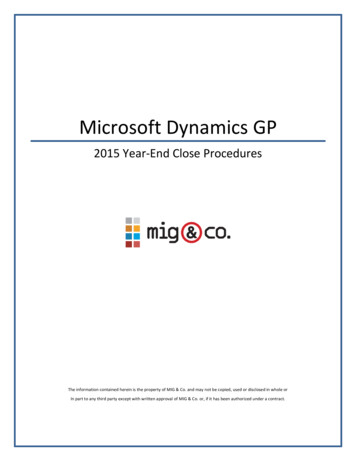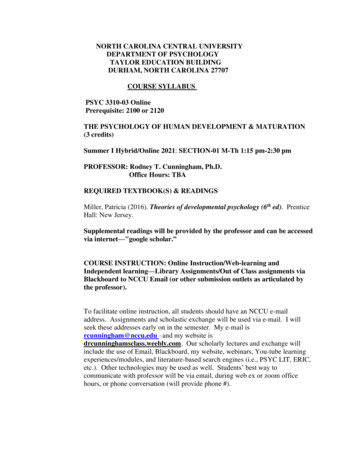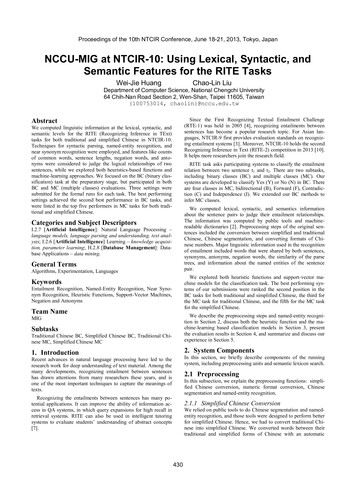
Transcription
3URFHHGLQJV RI WKH WK 17&,5 &RQIHUHQFH -XQH 7RN\R -DSDQNCCU-MIG at NTCIR-10: Using Lexical, Syntactic, andSemantic Features for the RITE TasksWei-Jie HuangChao-Lin LiuDepartment of Computer Science, National Chengchi University64 Chih-Nan Road Section 2, Wen-Shan, Taipei 11605, Taiwan{100753014, chaolin}@nccu.edu.twSince the First Recognizing Textual Entailment Challenge(RTE-1) was held in 2005 [4], recognizing entailments betweensentences has become a popular research topic. For Asian languages, NTCIR-9 first provides evaluation standards on recognizing entailment systems [3]. Moreover, NTCIR-10 holds the secondRecognizing Inference in Text (RITE-2) competition in 2013 [10].It helps more researchers join the research field.AbstractWe computed linguistic information at the lexical, syntactic, andsemantic levels for the RITE (Recognizing Inference in TExt)tasks for both traditional and simplified Chinese in NTCIR-10.Techniques for syntactic parsing, named-entity recognition, andnear synonym recognition were employed, and features like countsof common words, sentence lengths, negation words, and antonyms were considered to judge the logical relationships of twosentences, while we explored both heuristics-based functions andmachine-learning approaches. We focused on the BC (binary classification) task at the preparatory stage, but participated in bothBC and MC (multiple classes) evaluations. Three settings weresubmitted for the formal runs for each task. The best performingsettings achieved the second best performance in BC tasks, andwere listed in the top five performers in MC tasks for both traditional and simplified Chinese.RITE task asks participating systems to classify the entailmentrelation between two sentence t1 and t2. There are two subtasks,including binary classes (BC) and multiple classes (MC). Oursystems are developed to classify Yes (Y) or No (N) in BC. Thereare four classes in MC, bidirectional (B), Forward (F), Contradiction (C) and Independence (I). We extended our BC methods toinfer MC classes.We computed lexical, syntactic, and semantics informationabout the sentence pairs to judge their entailment relationships.The information was computed by public tools and machinereadable dictionaries [2]. Preprocessing steps of the original sentences included the conversion between simplified and traditionalChinese, Chinese segmentation, and converting formats of Chinese numbers. Major linguistic information used in the recognitionof entailment included words that were shared by both sentences,synonyms, antonyms, negation words, the similarity of the parsetrees, and information about the named entities of the sentencepair.Categories and Subject DescriptorsI.2.7 [Artificial Intelligence]: Natural Language Processing –language models, language parsing and understanding, text analysis; I.2.6 [Artificial Intelligence] Learning – knowledge acquisition, parameter learning; H.2.8 [Database Management]: Database Applications – data mining.General TermsAlgorithms, Experimentation, LanguagesWe explored both heuristic functions and support-vector machine models for the classification task. The best performing systems of our submissions were ranked the second position in theBC tasks for both traditional and simplified Chinese, the third forthe MC task for traditional Chinese, and the fifth for the MC taskfor the simplified Chinese.KeywordsEntailment Recognition, Named-Entity Recognition, Near Synonym Recognition, Heuristic Functions, Support-Vector Machines,Negation and AntonymsTeam NameTraditional Chinese BC, Simplified Chinese BC, Traditional Chinese MC, Simplified Chinese MCWe describe the preprocessing steps and named-entity recognition in Section 2, discuss both the heuristic function and the machine-learning based classification models in Section 3, presentthe evaluation results in Section 4, and summarize and discuss ourexperience in Section 5.1. Introduction2. System ComponentsRecent advances in natural language processing have led to theresearch work for deep understanding of text material. Among themany developments, recognizing entailment between sentenceshas drawn attentions from many researchers these years, and isone of the most important techniques to capture the meanings oftexts.2.1 PreprocessingMIGSubtasksIn this section, we briefly describe components of the runningsystem, including preprocessing units and semantic lexicon search.In this subsection, we explain the preprocessing functions: simplified Chinese conversion, numeric format conversion, Chinesesegmentation and named-entity recognition.Recognizing the entailments between sentences has many potential applications. It can improve the ability of information access in QA systems, in which query expansions for high recall inretrieval systems. RITE can also be used in intelligent tutoringsystems to evaluate students’ understanding of abstract concepts[7].2.1.1 Simplified Chinese ConversionWe relied on public tools to do Chinese segmentation and namedentity recognition, and those tools were designed to perform betterfor simplified Chinese. Hence, we had to convert traditional Chinese into simplified Chinese. We converted words between theirtraditional and simplified forms of Chinese with an automatic
3URFHHGLQJV RI WKH WK 17&,5 &RQIHUHQFH -XQH 7RN\R -DSDQprocedure which relied on a tool in the packages of MicrosoftWord. We did not design or invent a conversion dictionary of ourown, and the quality of conversion depended solely on MicrosoftWord.dictionary. The dictionary was applied to check whether the sentences have opposite meanings.Furthermore, antonyms may also be used to represent oppositemeanings in two sentences. Hence, our system should be capableof capturing antonyms in sentences. We detect antonyms by anantonym dictionary that was provided by the Ministry of Education in Taiwan [1].2.1.2 Numeric Format ConversionThere are several formats of numbers in Chinese. The differencesbetween numeric formats may lead to ambiguous interpretationsof sentences. In order to solve the problem, regular expressionswere used to capture specific strings and converted Chinese numerals into Arabic numerals. Figure 1 shows an example of theconversion.In our approach, we tried to retrieve synonyms to improve ourability in identifying overlapping words in sentence pairs. Basedon E-HowNet expressions, we proposed a method to compute thesimilarity between words and output a confidence score from 0 to1. We would then set a threshold to tell whether two words weresynonyms by experiments.Original: 喯⑰ 㓧㪲 ᶨḅḅℓ⸜Ḽ㚰 ᶨ㖍䳸㜇(The Suharto regime ended in May 21, 1998)To compare whether two words are similar, we first parse theirE-HowNet expressions into tree structures as shown in Figure 4.Each node represents one primitive, function word, or a semanticrole. From the tree structures, we can realize the relations betweennodes. We think the relations show how two words share theirsemantics in more details. We compute the similarity between twowords by how their tree structures match, and output a similarityscore.Conversion: 喯⑰ 㓧㪲 1998 ⸜ 5 㚰 21 㖍䳸㜇Figure 1. Numeric Format Conversion Example2.1.3 Chinese SegmentationWords are separated by spaces in English sentences, but it is quitedifferent in Chinese. It is much harder for computers to separateindividual words in Chinese strings. Figure 2 shows an example ofChinese segmentation. In addition, the meanings of Chinese sentences may change because of different segmentation results. Stanford Word Segmenter was used to generate Chinese segmentationsin our system [9].Word: 㻚 (Increase in price)Expression: {BecomeMore :domain {economy 䴻㾇},theme {price({object 䈑橼})}}Tree:Original: 劍㛃ᾅ䤧Ḵᶾ㗗㔁 柀 Ṣ(John Paul II is the national leader of the Holy City)Segmented: 劍㛃ᾅ䤧 Ḵ ᶾ 㗗 㔁 柀 ṢFigure 2. Chinese Segmentation Example2.1.4 Named-entity RecognitionWe expect that proper nouns provide important information forentailment recognition. S-MSRSeg is an NER tool developed byMicrosoft Research in 2005 [5]. We used it to identify names ofpersons, locations and organizations. In Section 3, we will describe how to use information about named entities to recognizeentailments.Figure 4. E-HowNet Expression and Tree StructureWord: 㹞妋 (dissolve)3. Recognition MethodsExpression: {StateChange ン嬲:StateFin {StateLiquid 㵚ン}}We applied different linguistic information to recognize entailment between two sentences. Several NLP tools, dictionaries andsemantic resources were used to construct the heuristic functionsand to extract features from sentences. The features were trainedas classification models by machine learning algorithms. Initially,we focused on recognizing binary relations when we designedthese two approaches. A while later, we determined to participatein MC tasks and chose to generate our decisions based on BCmodels. Figure 5 shows the inferences from BC to MC. Noticethat we did not do the Contradiction decisions with the right model,Figure 3. E-HowNet Lexical Sense Expression2.2 Lexical SemanticsWe are also in the belief that synonyms, antonyms and negationwords in sentences are important in judging the meanings of sentences. E-HowNet employs an entity-relation model to representlexical senses. It contains 88079 traditional Chinese words in its2012 version. Word senses are defined by primitives, concepts andconceptual relations. Figure 3 shows a lexical sense expression inE-HowNet.if t1 t2 ’ Y’ and t2 t1 ‘N’ then output ‘F’if t1 t2 ‘Y’ and t2 t1 ‘Y’ then output ‘B’Some words are often used to express negation meanings.Hence, we want to capture these words in sentences. We retrievedwords whose E-HowNet expressions contain function word “not”,and they were filtered manually to construct a negation wordsif t1 t2 ’ N’ and t2 t1 ‘N’ then output ‘I’if t1 t2 ’ N’ and t2 t1 ‘Y’ then output ‘C’Figure 5. Inferences from BC to MC
3URFHHGLQJV RI WKH WK 17&,5 &RQIHUHQFH -XQH 7RN\R -DSDQFigure 6. System Architectureand our performance in this category in the formal runs reflectedthis flaw.t1: 劍㛃ᾅ䤧Ḵᶾ㗗 䘦Ḽ ⸜Ἦ䫔ᶨỵ朆朆 佑 䯵䘬㔁 (John Paul II is the first non-Italian Pope in the past fourhundred and fifty years)3.1 Heuristic FunctionsFigure 6 shows the system architecture with which we learned thethreshold from training data for entailment decisions and used tocompute scores of test data. First, preprocessing steps mentionedin Section 2.1 are done. After that, we computed the ingredientsfor the final scores step by step. The process will output a score ofeach sentence pair from 0 to 1. The scores could be used for training purposes, and could be used to determine entailments of testdata.t2烉劍㛃ᾅ䤧Ḵᶾ㗗 䘦Ḽ ⸜Ἦ䫔ᶨỵ佑 䯵䘬㔁 (John Paul II is the first Italian Pope in the past four hundred and fifty years)Figure 7. Negation Word Leads to Opposite MeaningSometimes the ratio of overlapping words is extremely high, butt1 does not really entail t2. Figure 7 illustrates this problem. Negation words change the meanings of sentences; they often maketotally opposite meanings from one to another. Therefore, it isdesirable to be capable of identifying negation words. In addition,we add another step to examine whether two sentences share thesame number of negation words. Hence, the function is furtherrefined to:Intuitively, a sentence t1 is much easier to imply another sentence t2 if they share more common words. Hence, we determinedentailments based on the proportion of shared words in the sentence pair. Obviously, the same concept may not be expressed inexactly the same terms. Hence, we search synonyms between t1and t2 to obtain a better estimate of the ratio. The ratio of wordsoverlapping is defined as follows: ൌ ݂ை௩ ሺܶଵ ǡ ܶଶ ሻ ൌ ൌ ݂ை௩ ሺܶଵ ǡ ܶଶ ሻ െ ݂ோா௫ ௦௧ ሺ ݐ ଵ ǡ ݐ ଶ ሻെ ݂ே ௧ ሺ ݐ ଵ ǡ ݐ ଶ ሻǡȁ்భ ்ת మ ȁȁ்మ ȁ,where fNegDet is the penalty that t1 and t2 do not have the samenumber of negation words. The penalty was defined between 0and 1.where T1 and T2 are the set of words after t1 and t2 are segmented.As we mentioned earlier, NEs are expected to be important information in sentences. Based on the ratio of overlapping words,we further checked whether the NEs retrieved from t2 appear in t1simultaneously. If there are NEs from t2 which are not shown in t1,we believe that it is much harder to say t1 entails t2. The functionbecomes:Antonyms also can lead to opposite meanings between sentences. Unlike negation words, we believed that antonyms are mucheasier to show there were possible opposite meaning and noneentailment between two sentences. Hence, we want to decrease theentailment score heavily to indicate this problem. We then modified our function as below: ൌ ݂ை௩ ሺܶଵ ǡ ܶଶ ሻ െ ݂ோா௫ ௦௧ ሺ ݐ ଵ ǡ ݐ ଶ ሻǡ ൌ ೀೡ ೌ ሺ்భ ǡ்మ ሻି ಿಶಶೣ ೞ ሺ௧భ ǡ௧మ ሻି ಿ ವ ሺ௧భ ǡ௧మ ሻ ಲ ವ ሺ்భ ǡ்మ ሻ݂ோா௫ ௦௧ ሺ ݐ ଵ ǡ ݐ ଶ ሻ ൌ ߙ ൈ ݐ݊ݑ ܥ ሺ ݐ ଵ ǡ ݐ ଶ ሻ,,where fAntonymDet is the penalty, in the range [1, 2], when any somewords in t1 and t2 are antonyms.where Count(t1,t2) returns the numbers of NEs in t2 that do notappear in t1 and α is the penalty manually chosen between 0 and 1based on some experiment results.
3URFHHGLQJV RI WKH WK 17&,5 &RQIHUHQFH -XQH 7RN\R -DSDQNEs carry important information as we have mentioned. Whenwe began to consider the syntactic structures, we found that NEs’orders played a significant role in recognizing entailments. Whenthe score computed from previous steps is high, two sentencesmay share many words, suggesting they are about the same events.However, differences in NEs’ orders possibly change the meanings of sentences because the subjects and objects may beswitched. We tried to retrieve the differences of NEs’ orders anddecreased entailment score by specified penalty. Moreover, syntactic structures should be considered to avoid the usage of passivesentences in the future. Our function with NEs’ orders is improvedby:(1) Words' Overlapping Ratio(2) NE Quantities ( NEt1 , NEt2 )(3) NEt2 Match Ratio in t1(4) NEt2 Not Match Quantities in t1(5) Sentence Length (Lent1, Lent2)(6) Sentence Length Comparison(7) Parse Tree Matching Ratio(8) Negation Words Quantities ( Negt1 , Negt2 )(9) Negt2 Match Ratio in t1(10) Synonym Quantities (Synset)(11) Synonym Ratio ݂ை௩ ሺܶଵ ǡ ܶଶ ሻ െ ݂ோா௫ ௦௧ ሺ ݐ ଵ ǡ ݐ ଶ ሻ െ ݂ே ௧ ሺ ݐ ଵ ǡ ݐ ଶ ሻൌ݂ ௧ ௬ ௧ ሺܶଵ ǡ ܶଶ ሻ ൈ ݂ோை ௗ ሺ ݐ ଵ ǡ ݐ ଶ ሻFigure 8. Features(1) Words' Overlapping Ratio*(2) NE Quantities ( NEt1 , NEt2 )*(3) NEt2 Match Ratio in t1*(4) NEt2 Not Match Quantities in t1*(5) Sentence Length (Lent1, Lent2)*(6) Sentence Length Comparison*(7) Parse Tree Matching Ratio*(8) Negation Words Quantities ( Negt1 , Negt2 )(9) Negt2 Match Ratio in t1(10) Synonym Quantities (Synset)(11) Synonym Ratiowhere fNEOrder is the penalty whenever the NEs’ orders in t1 aredifferent in t2 and its range is between 1 and 2.We have been done many experiments to set up the entailmentthreshold and penalties. In the next section, we explain anotherapproach of our system.3.2 Classification ModelsTo compare with the approach of heuristic functions, we useddifferent combinations of lexical and syntactic features to trainclassification models to recognize entailments between sentences.Classification algorithms were used to automatically analyze andto learn the generality from data. The trained models were furtherused to predict the classifications of new instances. In this section,we list the features used to train classification models as shown inFigure 8.* (1) – (7) were used to train simplified Chinese modelFigure 9. Features to Train Modelsels. We compared the two algorithms on their 10-fold crossvalidation performance with several combinations of features. Themodels trained by LibSVM provided better performance than themodels trained by C50. Hence, we used LibSVM to train the classification models [6]. The models were used to classify BC results.To recognize MC results, we swapped t1 and t2 to extract featuresand classified their BC results. MC results were generated fromthe two BC results as the inferences shown in Figure 5.For quick implementation, we extracted features as Section 3.1described: ratio of overlapping words, counts of named entities,counts of negation words, and synonyms etc. These features wereconsidered to tell how the two sentences shared linguistic information at lexical level. Also, the lengths of sentences were thoughtas an important feature. Many of the sentences pairs were classified as entailment when the length of t1 was longer than the lengthof t2. Hence, we extracted the lengths of sentences and generatedBoolean features to show if the length of t1 is longer than thelength of t2.4. EvaluationIn this section, we describe the settings of our systems for formalruns. We also discuss systems performance based on the evaluation results.In addition to the lexical level features, syntactic features areconsidered to show if the two sentences use similar syntacticstructures. A sentence structure is similar to another when theyhave more common patterns in parse trees. Stanford Parser wasused to generate parse trees of t1 and t2 [8]. We proposed a simplemethod to compute the syntactic similarity between t1 and t2 and tooutput similarity scores from 0 to 1. Subtrees were retrieved fromeach parse tree. We calculated the ratio of matching subtrees asfollows:We participated in both BC and MC subtasks for traditional andsimplified Chinese. There are 881 and 781 sentence pairs withoutlabeling answers in traditional and simplified Chinese testing sets.Our systems are able to output BC results. MC results were inferred by BC results afterwards.4.1 SettingsFor each subtask, we submitted three runs for the testing sets. Weset up three different settings for this purpose. ሺܶ ݎ ଵ ǡ ܶ ݎ ଶ ሻหܵ ்݁݁ݎݐܾݑ భ ்݁݁ݎݐܾݑܵ ת మ หǡൌหܵ ்݁݁ݎݐܾݑ మ หRun 01: For the approach of heuristic functions, we had conducted many experiments to find the threshold and penalties to optimize our performance for the development sets. We did not consider synonyms in this setting.where SubtreeTr1 is the set of subtrees retrieved from the parse treeof t1.Run 02: We added the consideration for synonyms to achieve thesetting for Run 01. Based on results that we observed in explorative experiments, we would consider two words synonymous iftheir confidence score is greater than 0.88 (cf. Section 2.2).Without external data sets, we used development sets to trainthe classification models. The development sets of traditional andsimplified Chinese consist 1321 and 814 sentence pairs individually. C50 and LibSVM were selected to train the classification mod-Run 03: We trained two separate SVM models for traditional andsimplified Chinese. The features to train models were searched for
3URFHHGLQJV RI WKH WK 17&,5 &RQIHUHQFH -XQH 7RN\R -DSDQthe highest 10-fold cross-validation accuracy of the developmentsets. Figure 9 shows the features for training the two models. Thefeatures marked with star symbols were used to train simplifiedChinese model.ed instrumental help to the overall performance. The score components that considered the named entities enhanced the performance of our systems, as indicated by the performance of the setting of Run 02. We have not achieved good results using the SVMmodels, which remains as an item for future work.4.2 Formal Run ResultsFurther examination of the judgments of our systems showedthe weakness of the current systems. There is room for improvingthe contributions of negation words and antonyms. Our ability toidentify temporal relationships remained to be enhanced. Someforms of automatic or semi-automatic detection and identificationof negation expression, antonymous relationships, and time stampsare greatly desirable.Table 1 and Table 2 show the results of the formal runs of BC andMC subtasks. Because our system development focused on the BCsubtasks, we discuss the results of only BC subtasks.Table 1 shows our performance in the BC subtasks. Weachieved better results with the setting of Run 02 than with thesetting of Run 01. We used our synonym retrieval method to figure out whether two words are synonyms in the setting of Run 02.The results indicate that synonyms are useful to improve the system performance on recognizing binary relations. Moreover, Run03 results show the capability of the two models trained by different features. The model of traditional Chinese still had great ability to recognize the entailments between sentences, but the modelof simplified Chinese did not receive similar results. As figure 9shows, negation words and synonyms were not used to train themodel of simplified Chinese, because the combination of featuresdid not receive higher cross-validation performance on the development set. Without negation words and synonyms, we thinksome linguistic information was lost to train recognition models.Hence, the result of Run 03 in simplified Chinese was droppeddown sharply.For the formal runs, we adopted SVM models for the machinelearning approach, but did not achieve results that we expected. Insome follow-up experiments, we switched to weighted linearlyscore functions and learned the weights for the selected features.Reasonable and encouraging results were observed, and will bereported in future reports.AcknowledgementsThis work was supported in part by the grants NSC-100-2221-E004-014- and NSC-101-2221-E-004-018- from the National Science Council, Taiwan.References[1] Chinese Dictionary from Ministry of Education.http://dict.revised.moe.edu.tw/ [2013/02/01]In terms of the ranked results of the formal runs for both BCand MC and for both traditional and simplified Chinese, we performed relatively good compared with most other systems.[2] Extended-HowNet. http://ehownet.iis.sinica.edu.tw/[2013/02/01][3] Hideki Shima, Hiroshi Kanayama, C.-W. Lee, C.-J. Lin,Teruko Mitamura, Yusuke Miyao, Shuming Shi and KoichiTakeda. 2011. Overview of NTCIR-9 RITE: Recognizing Inference in TExt, Proceedings of NTCIR-9 Workshop Meeting,291-301.Table 1. Formal Run Results of BC SubtaskCTCSRun 0165.4265.71Run 0267.0768.09Run 0366.9957.19[4] Ido Dagon, Oren Glickman and Bernardo Magnini, ThePASCAL Recognising Textual Entailment Challenge, InQuiñonero-Candela,J.; Dagan, I.; Magnini, B.; d'Alché-Buc,F.(Eds.), Machine Learning Challenges. Lecture Notes inComputer Science, Vol. 3944, 177-190, Springer, 2006.Table 2. Formal Run Results of MC SubtaskCTCSRun 0142.1641.82Run 0245.1544.74Run 0344.2134.42[5] Jianfeng Gao, Mu Li, Andi Wu and Chang-Ning Huang.2005. Chinese Word Segmentation and Named EntityRecognition: A Pragmatic Approach, Computational Linguistics, 31(4).[6] LibSVM – A Library for Support Vector Machines.http://www.csie.ntu.edu.tw/ cjlin/libsvm/ [2013/02/01]5. Discussions[7] Rodney D. Nielsen, Wayne Ward, and James H. Martin. 2009.Recognizing entailment in intelligent tutoring systems. JOurnal of Natural Language Engineering. 15(4): 479-501.We explored two approaches to recognize entailments, employingpublic tools for Chinese segmenter, syntactic parsing, namedentity recognition, and additional semantic resources. Heuristicfunctions and SVM models which considered different combinations of the linguistic features were proposed and applied to theRITE tasks. Our systems performed relatively well in the formalruns. We achieved the second best scores for the BC subtasks forboth traditional and simplified Chinese, and ranked among the topfive teams for the MC subtasks. The results suggest the generalapplicability of the considered features and explored methods.[8] Stanford Parser. http://nlp.stanford.edu/software/lexparser.shtml [2013/02/01][9] Stanford Word er.shtml [2013/02/01][10] Yotaro Watanabe, Yusuke Miyao, Junta Mizuno, TomohideShibata, Hiroshi Kanayama, C.-W. Lee, C.-J. Lin, ShumingShi, Teruko Mitamura, Noriko Kando, Hideki Shima andKohichi Takeda. 2013. Overview of the Recognizing Inference in Text (RITE-2) at the NTCIR-10 Conference, Proceedings of NTCIR-10 Conference.The proportion of words shared by the sentence pairs formed animportant basis in our heuristic functions. It is certainly risky justto rely on words that were literally the same in computing theshared words. Results of some internal evaluations showed thatour computing near synonyms with the help of E-HowNet provid-
NCCU-MIG at NTCIR-10: Using Lexical, Syntactic, and Semantic Features for the RITE Tasks Wei-Jie Huang Chao-Lin Liu Department of Computer Science, National Chengchi University 64 Chih-Nan Road Section 2, Wen-Shan, Taipei 11605, Taiwan {100753014, chaolin}@nccu.edu.tw Abstract We computed linguistic information at the lexical, syntactic, and



